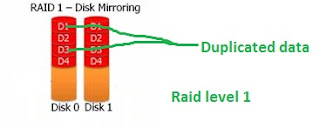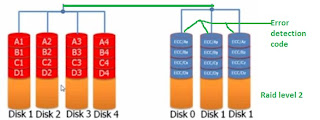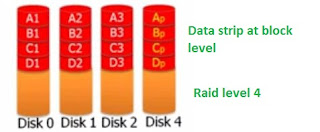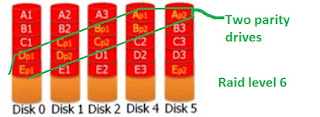Different raid level in database
The word RAID means Redundant Arrays of Independent/Inexpensive Disks. In many web application, database application we need to store big data. To store this data we need many hardware disk. Large number of disks helps you to read or write data item in very short time. There are many kinds of RAID or hardware disks. Each disks has special characteristics. Some disks reliable but not good in performance. Here I explain different raid levels in database :
RAID level 0 : Raid level 0 is non redundant disk array. That means in the disk of raid 0 has no extra/redundant information. Raid 0 offers best performance because it never needs to update redundant data. In raid 0 if either disk fails, all data is lost. The data is divided into block and distributed across drives in array. Two disk used most often, half data on each disk. Non redundant disk arrays are widely used in super computing environment. To understand raid level 0 see this image below:
Raid level 1 : Raid level 1 is called mirror raid level with block level striping. In raid level 1 data is duplicated on second disk. Raid 1 exists data redundancy. That means if either drive fails, data can be read or write from duplicate disk. Raid 1 is useful when read performance or reliability is more important than data storage capacity. It is high costly because raid 1 store duplicate data. Take a look at the image to understand raid level 1:
Raid level 2 : Raid level 2 is an array of disks where data is striped at bit level across all disk in array. It uses Haming Code for error correction and detection. Haming Code contain parity for distinct overlapping subsets of components. Raid 2 use extra disks to store error correction code. This raid is high performance raid and use to recover error but not implementable in practical life. Look at the picture on raid level 2:
Raid level 3 : Raid 3 is called striping with parity. In raid 3 data striped at byte level on separate drives. Parity ( error detection and correction code ) stored on another dedicated disk. In any drive fails, data is recovered with remaining parity disk. Parity is a form of error correction or detection code that uses a single bit to represent the odd or even quantities of 1 and 0 in the data item. Parity usually consists of one parity bit for each eight bits of data. Here I given below the picture of Raid level 3:
Raid level 4 : Raid 4 is very similar to raid 3. In Raid 4 data is striped at block level rather than byte level. Raid 4 slightly higher read performance than raid 3. See the picture below:
Raid level 5 : In raid 5 data is stripped with distributed parity. The data divided into even number of blocks, and with additional parity block. In raid 5 each set blocks store one parity and different blocks ( see the picture ). If any drive fails, data recovered with remaining blocks and parity information. But a disk failure would result in loss of data as well as parity information and the disk would not be recoverable. Level 5 subsumes level 4, it offers better read-write performance than raid 4.
Raid level 6 : Raid 6 is very similar to Raid 5 except two parity drives are used instead of one parity disk ( raid 5 used one parity disk but raid 6 used 2 distributed parity disk). Raid 6 stores extra redundant information to guard against multiple disk failures. Instead of using parity disk sometimes it uses error correcting codes such as Reed-Solomon codes. The recover process of single drive in Raid 6 is very faster. See the picture below to understand raid 6:
RAID level 0 : Raid level 0 is non redundant disk array. That means in the disk of raid 0 has no extra/redundant information. Raid 0 offers best performance because it never needs to update redundant data. In raid 0 if either disk fails, all data is lost. The data is divided into block and distributed across drives in array. Two disk used most often, half data on each disk. Non redundant disk arrays are widely used in super computing environment. To understand raid level 0 see this image below:
Raid level 1 : Raid level 1 is called mirror raid level with block level striping. In raid level 1 data is duplicated on second disk. Raid 1 exists data redundancy. That means if either drive fails, data can be read or write from duplicate disk. Raid 1 is useful when read performance or reliability is more important than data storage capacity. It is high costly because raid 1 store duplicate data. Take a look at the image to understand raid level 1:
Raid level 2 : Raid level 2 is an array of disks where data is striped at bit level across all disk in array. It uses Haming Code for error correction and detection. Haming Code contain parity for distinct overlapping subsets of components. Raid 2 use extra disks to store error correction code. This raid is high performance raid and use to recover error but not implementable in practical life. Look at the picture on raid level 2:
Raid level 3 : Raid 3 is called striping with parity. In raid 3 data striped at byte level on separate drives. Parity ( error detection and correction code ) stored on another dedicated disk. In any drive fails, data is recovered with remaining parity disk. Parity is a form of error correction or detection code that uses a single bit to represent the odd or even quantities of 1 and 0 in the data item. Parity usually consists of one parity bit for each eight bits of data. Here I given below the picture of Raid level 3:
Raid level 4 : Raid 4 is very similar to raid 3. In Raid 4 data is striped at block level rather than byte level. Raid 4 slightly higher read performance than raid 3. See the picture below:
Raid level 5 : In raid 5 data is stripped with distributed parity. The data divided into even number of blocks, and with additional parity block. In raid 5 each set blocks store one parity and different blocks ( see the picture ). If any drive fails, data recovered with remaining blocks and parity information. But a disk failure would result in loss of data as well as parity information and the disk would not be recoverable. Level 5 subsumes level 4, it offers better read-write performance than raid 4.
Raid level 6 : Raid 6 is very similar to Raid 5 except two parity drives are used instead of one parity disk ( raid 5 used one parity disk but raid 6 used 2 distributed parity disk). Raid 6 stores extra redundant information to guard against multiple disk failures. Instead of using parity disk sometimes it uses error correcting codes such as Reed-Solomon codes. The recover process of single drive in Raid 6 is very faster. See the picture below to understand raid 6:










Comments
Post a Comment